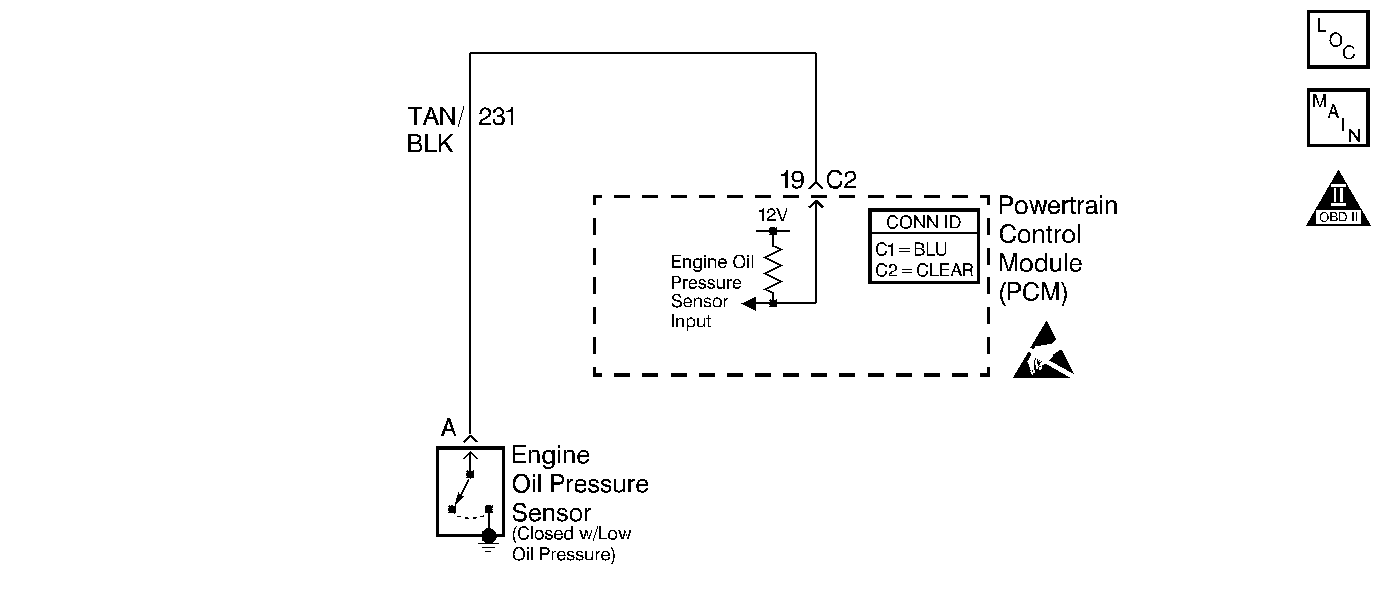Engine Oil Pressure Switch Diagnosis

Circuit Description
The PCM applies battery voltage through a pull up resistor to the Engine Oil Pressure Switch circuit. The PCM monitors the applied voltage on the Engine Oil Pressure Switch circuit. If the ignition switch is turned ON with the engine not running or engine oil pressure is below 35 kPa (5 psi), the Engine Oil Pressure switch grounds the PCM voltage input. The PCM sends the engine oil pressure information via Class II serial data to the Instrument Panel Cluster (IPC). The IPC controls the Engine Oil Pressure Indicator.
Diagnostic Aids
Check for the following condition(s):
| • | Poor connections. Inspect PCM and harness connectors for backed out terminals, improper mating, broken locks, improperly formed or damaged terminals, and poor terminal to wire connection. |
| • | Damaged harness. Inspect the wiring harness for damage. If the harness appears to be OK, disconnect the Engine Oil Pressure switch, turn the ignition ON and observe a voltmeter connected between the Engine Oil Pressure switch connector terminals while moving wiring harnesses related to the Engine Oil Pressure Switch circuit. A change in voltage will indicate the location of the fault. |
Engine Oil Pressure Switch Diagnosis
Step | Action | Value(s) | Yes | No |
|---|---|---|---|---|
1 | Was the Powertrain On-Board Diagnostic (OBD) System Check performed? | -- | ||
2 | Are any PCM DTCs stored? | -- | ||
3 | Is the Engine Oil pressure Indicator ON? | -- | ||
4 | Check the engine for correct oil level. Is the Correct engine oil level indicated? | -- | ||
5 | Check the engine oil pressure with a manual pressure gauge. Refer to Oil Pressure Diagnosis and Testing . Is proper engine oil pressure indicated? | -- | ||
6 |
| -- | ||
7 |
Is Test light on? | -- | ||
8 |
Was a problem found? | -- | ||
9 |
Was a problem found? | -- | ||
10 | Locate and repair the following circuit condition(s):
Is action complete? | -- | -- | |
11 | Determine cause of low oil. Is action complete? | -- | -- | |
12 | Determine cause of low oil pressure. Is action complete? | -- | -- | |
13 | Check the Communication circuit for correct operation. Refer to Diagnostic System Check - Data Link Communications . Was a problem Found? | -- | ||
14 | Replace Engine Oil Pressure switch. Refer to Engine Oil Pressure Sensor and/or Switch Replacement . Is action complete? | -- | -- | |
15 |
Important: The replacement PCM must be programmed. Refer to Powertrain Control Module Replacement/Programming . Replace the PCM. Is action complete? | -- | -- | |
16 | Check for the proper operation of Oil Pressure Indicator. Refer to Diagnostic System Check - Instrument Cluster . Is the correct operation indicated? | -- | System OK |
